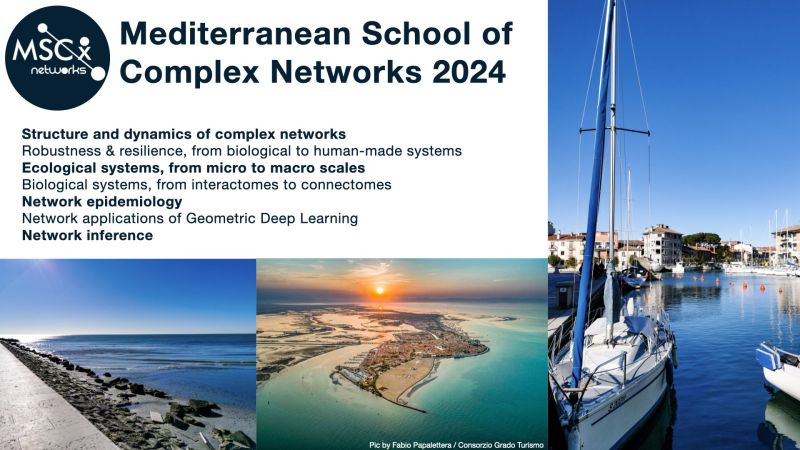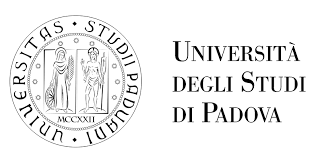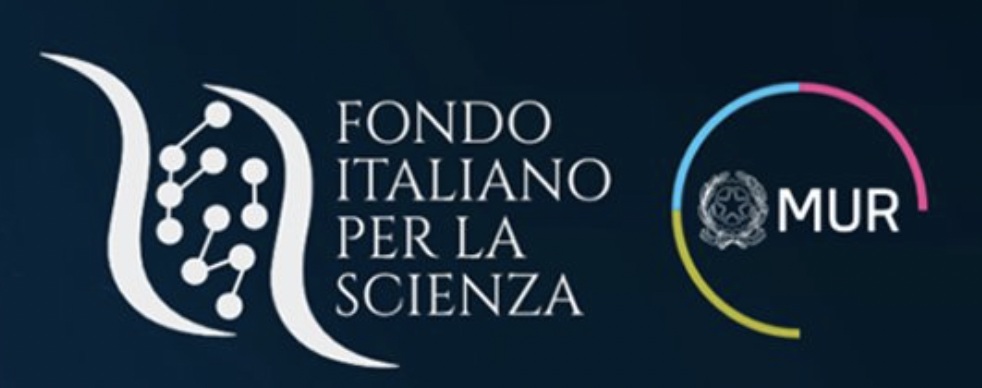IX Mediterranean School of Complex Networks
Grado, Italy 30 June - 5 July 2024Program
16:30 WELCOME
Meeting point at Venice airport with the School bus (details will be given by the end of May in the vademecum, while the time slot will not change to allow you to organize your flight accordingly)
OPENING & Individual Presentations
9:00 - 10:00
Giuseppe Mangioni (University of Catania, Italy)
Manlio De Domenico (University of Padua, Italy)
Session I: Navigating network dynamics
10:00 - 11:00 PART I
11:00 - 11:30 COFFEE BREAK
11:30 - 13:00 PART II
Baruch Barzel (Bar-Ilan University, Israel)
Universal network characteristics, such as the scale-free degree distribution and the small world phenomena, are the bread and butter of network science. But how do we translate such topological features into an understanding of the system's dynamic behavior: for instance, how does the small world structure impact the patterns of flow in the system? Or how does the presence of hubs affect the distribution of influence? These questions touch on the interplay between the network structure and its intrinsic nonlinear dynamics - a challenging combination that rarely succumbs to analytical treatment. It is therefore, no surprise that, upon observation, network dynamics seem diverse and unpredictable - a zoo of diverging timescales, propagation patterns, spreading dynamics and critical transitions. It seems, therefore, that the concept of universality, which ignited the field of network science at the turn of the century - this concept breaks down when it comes to dynamics, as diversity wins over universality. How, then, can we understand, predict and influence the network's actual behavior? Our research over the past decade offers an optimistic view on this question, by exposing the deep universality that characterizes network dynamics. This universality allows a systematic translation of structure into dynamics, from state transitions, to propagation timescales, localization, and spectral analysis. It allows us to expose the relevant parameters that actually control the system's behavior, and - ultimately - steer the system towards desired states with minimal intervention.
16:00 - 18:00 STUDENT TALKS
Network dynamics:
Adam Miles
Pablo Gallarta
Piergiorgio Castioni
Jaume Ojer Ferrer
Isabel Martínez Urbiola
Social, Urban and Climate networks:
Adamo Cerioli
Sofia Galli
Lorenzo Gamba
Jordi Grau Escolano
Machine learning and surroundings:
Yash Arya
Davide Cipollini
18:30 - 19:30 COCKTAIL NIGHT TALK
Some unanswered and unasked questions in microbial ecology
Jacopo Grilli (BICTP, Italy)
Within a drop of water or a grain of soil millions of microbes compete, cooperate, process information, modify the physical and chemical environment, adapt, and evolve. Microbial communities are composed by extremely diverse and complex organisms, which dynamically interact in complex and evolving ways. In this talk, I will review what are in my opinion the most interesting and exciting questions in the field to which complex systems scientists can contribute.
Session II: Sloppy modeling and the triumph of the spherical cow
9:30 - 11:00 PART I
11:00 - 11:30 COFFEE BREAK
11:30 - 12:30 PART II
Jose Cuesta (Universidad Carlo III de Madrid, Spain)
When modeling complex systems, as in biology, economics or social science, the number of variables and parameters needed to describe them is often very large. Most of these parameters cannot be measured, and even those that can be are often determined with huge errors (more than 100%). Despite the enormous difficulty in fine-tuning them, these models are commonly used in systems biology, epidemiology, ecology, etc., where they turn out to be very useful to make predictions. This is surprising, in view of the enormous uncertainty they hide. The term "sloppy model" has been coined to describe such systems. In the last decade, a number of authors have devoted themselves to studying the statistical geometry behind these systems and have reached interesting conclusions regarding the determinability. Their findings help understand some curious phenomena of complex systems, such as the surprising effectiveness of oversimplified models (the so-called "spherical cows"). I will try to explain what sloppy models are, what they tell us about modeling complex systems, the techniques to systematically reduce their complexity, and the epistemological implications that all this has for the physics of complex systems. All illustrated with examples taken from other authors and on my own research. I will finish by analysing the consequences that sloppines brings about when modeling ecological systems. In particular, I will show the impossibility to infer the interaction parameters of a Lotka-Volterra model from empirical data of either abundance time series or correlations.
STUDENT TALKS
16:00 - 17:30 PART I
Foundations of network science:
Leonardo Novelli
Lluís Torres Hugas
Amahury Jafet Lopez Diaz
Meixi Yuan
Biological and ecological networks:
Mitro Miihkinen
Laia Barjuan Ballabriga
Riccardo Sbarbati
Francesco Zambelli
17:30 - 18:00 COFFEE BREAK
18:00 - 19:00 PART II
Biological and ecological networks:
Luca Allegri
Daniil Vlasenko
Om Roy
Francesco Marcolli
David March Pons
François Thibault
Session III: Robustness and resilience of interconnected and interdependent systems
9:30 - 11:00 PART I
11:00 - 11:30 COFFEE BREAK
11:30 - 12:30 PART II
Manlio De Domenico (University of Padua, Italy)
We will explore the importance of robustness and resilience in complex interconnected and interdependent systems, ranging from biological entities to socio-ecological systems. Initially, I will provide an introductory perspective for classical networks, highlighting their structural and functional robustness by means of percolation theory and information dynamics. Our focus will then move to the multilayer networks — systems characterized by distinct layers of interaction and interdependence — analyzing their robustness and the implications of perturbations on information flow among constituent units.
To this aim, we will rely both on consolidated frameworks and on a novel framework bridging statistical physics with information theory to decode the complex interplay between network structure and dynamics. Applications to and implications for biological and socio-ecological systems will be discussed.
14:00 - 20:00 Social tour
9:30 - 11:00 Focused Seminars I
Inferring network models and reconstructing networks from data
Tiago Peixoto (Central European University, Austria)
We will provide a concise introduction to principled techniques for the detection of patterns and formation mechanisms from network data, grounded in Bayesian statistical inference and information theory. We will learn how to distinguish structure from statistical noise, how to perform uncertainty quantification, and to compare different generative models. We will also see how these ideas can be extended to reconstruct networks; both when their structure is measured directly but unreliably, and also when the structure is not measured directly at all, and needs to be uncovered from time-series or other indirect non-network data.
11:00 - 11:30 COFFEE BREAK
11:30 - 13:00 Focused Seminars II
Modeling epidemics: From Toy Models to Real-World Applications
Clara Granell (URV, Spain)
Infectious diseases propagate among individuals according to specific patterns of transmissibility. To model the unfolding of such spreading events within a population, we employ mathematical models that simulate the transmission dynamics of a pathogen across a network of interactions. This seminar aims to elucidate various epidemic modeling approaches, ranging from basic models that offer a broad, robust understanding of the phenomena to more complex models suitable for application in real-world situations.
Initially, we will delve into the most widely adopted compartmental models for epidemic spread, namely the Susceptible-Infectious-Susceptible (SIS) and Susceptible-Infectious-Recovered (SIR) models, addressing both scenarios of a homogeneously mixed population and those involving heterogeneous infectivity among individuals. Subsequently, we introduce the Microscopic Markov Chain Approach (MMCA), an advanced technique that facilitates detailed mathematical modeling of epidemic spread on a network, leveraging its full structural complexity.
Building upon these foundations, we will then examine the widespread dissemination of epidemics through a Meta-Population framework, which considers various populations interconnected by mobility or migration flows. Ultimately, we will synthesize all the previous concepts to construct a model that not only accurately depicts the transmission of an actual disease, such as COVID-19, but also serves as a practical tool for informing policy decisions.
16:00 - 17:30 Focused Seminars III
Modeling Ecosystems: from microscopic interactions to macroscopic patterns
Sandro Azaele (University of Padua, Italy)
The exploration of the links between the microscopic interactions of point-like particles and their emergent, observable patterns dates back to the dawn of statistical mechanics. The methodologies have greatly expanded their applicability, transcending the physical science origins to shed light on phenomena in distant domains. Today we have tools to understand systems where individual entities interact and produce large scale patterns. This is particularly relevant in Ecology and Biology, disciplines that present unique challenges not encountered in the realm of Physics. Ecological systems, though not akin to physical systems in thermal equilibrium, exhibit general laws, and their highly diverse communities share remarkable elements of universality.
I will survey the main approaches to modelling ecosystems with a large number of interacting species. This will first include an exposition of key patterns that can be measured and then I will develop some simple models which account for them. In the second part I will introduce the Dynamical Mean Field Theory (DMFT) which can be applied to disordered systems with many interacting degrees of freedom. Originally emerged from condensed matter physics as a powerful tool for investigating the properties of strongly interacting electron systems, more recently it has been applied to ecology for unveiling the emergent and universal traits inherent in complex biological systems.
Within the ecological context, DMFT offers a methodology to encapsulate the dynamics of large scale ecosystems by averaging the effects of microscopic interactions, eventually obtaining a single, effective equation for the whole system. This approach empowers researchers to investigate ecosystem-wide characteristics such as stability, resilience, and response to perturbations, thereby simplifying the underlying complexity.
17:30 - 18:00 COFFEE BREAK
18:00 - 19:00 PROJECTS TIME
20:00 - 23:00 SOCIAL DINNER
9:30 - 11:00 Focused Seminars IV
Biological networks from interactomes to connectomes: theory, applications and next challenges
Valeria D'Andrea (University of Padua, Italy)
The first part of the talk will focus on the molecular components within biological systems. Specifically, I will show recent advancements in the fields of network biology and network medicine, elucidating the role that network science has played in shaping these disciplines. Moreover, I will highlight the current challenges that must be addressed to ensure more successful applications and reproducible results. In the second part, I will shift the focus to brain networks, showing how structural properties and brain functioning can be effectively described and analyzed through the lens of network science. Furthermore, I will illustrate how specific classes of bio-inspired neural network models can be used to gain insights into the organization and function of complex brain networks. Finally, I will show how various statistical approaches to the reconstruction of structural and functional brain networks can significantly impact the robustness and interpretation of the presented results.
11:00 - 11:30 COFFEE BREAK
11:30 - 13:00 Focused Seminars V
MARCO GRASSIA: Machine learning hard problems on networks: dismantling
Marco Grassia (University of Catania, Italy)
The first part of lecture motivates and introduces the machine learning techniques on networks – commonly known as Geometric Deep Learning – which allow training a model on network data, including multi-layer and temporal ones, with the spotlight being on Graph Neural Networks and the underlying message-passing that allow embedding nodes into a (latent) Euclidean space.
The second part of the lecture will address network dismantling, a computationally challenging problem, and the state-of-the-art techniques, including trainable algorithms for site and bond attacks.
16:00 - 17:30 PROJECTS PRESENTATION
17:30 - 18:00 COFFEE BREAK
18:00 - 19:00 AWARD & CLOSING CERIMONIES
Topics
|

|
Committees
| Lecturers | Speaker | School Directors | |
|---|---|---|---|
| 1 | Baruch Barzel (Bar-Ilan U, Israel) | Clara Granell (URV, Spain) | Alex Arenas (URV, Spain) |
| 2 | Manlio De Domenico (UNIPD, Italy) | Sandro Azaele (UNIPD, Italy) | Vincenza Carchiolo (UNICT, Italy) |
| 3 | JOSE CUESTA (Universidad Carlo III de Madrid, Spain) | Marco Grassia (UNICT, Italy) | Manlio De Domenico (UNIPD, Italy) |
| 4 | Valeria D'Andrea (UNIPD, Italy) | Mattia Frasca (UNICT, Italy) | |
| 5 | Tiago Peixoto (CEU, Austria) | Giuseppe Mangioni (UNICT, Italy) | |
| 6 | Jacopo Grilli (ICTP, Italy) | Local organizing | |
| 7 | Agnello Serafina | ||
| 8 | Fichera Georgia | ||
| 9 | TOMAS SCAGLIARINI (UNIPD, Italy) |





